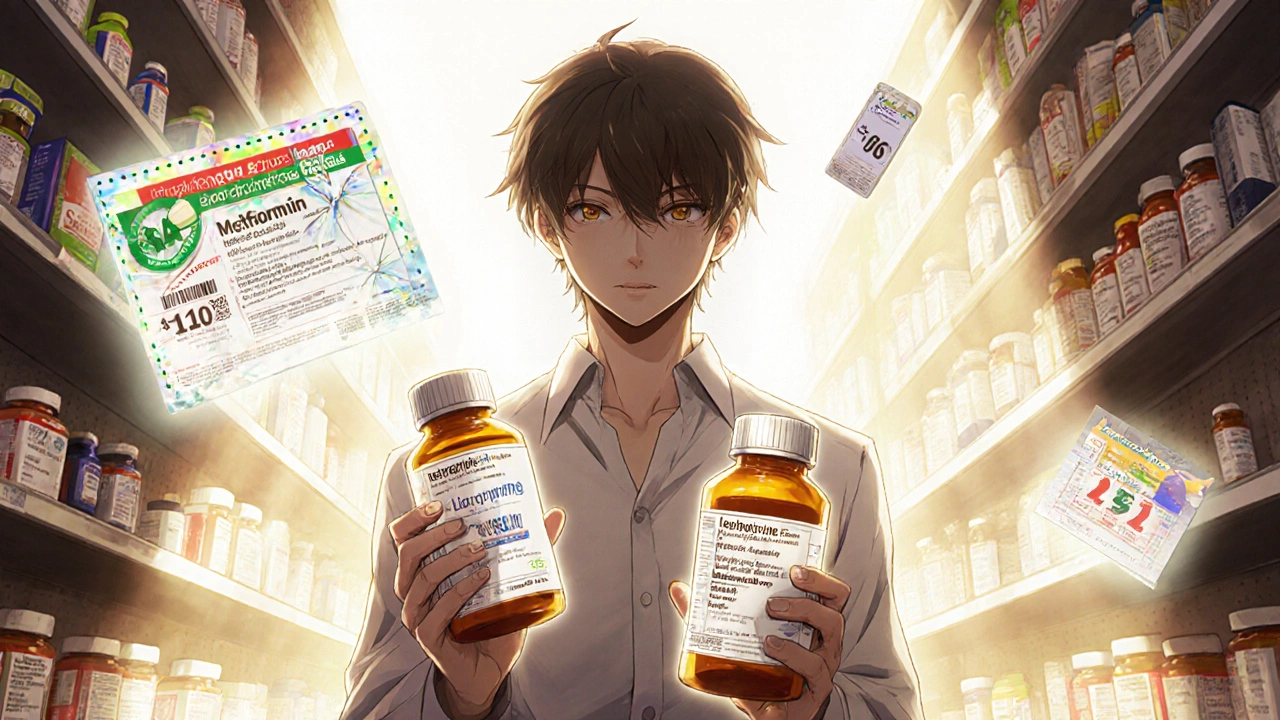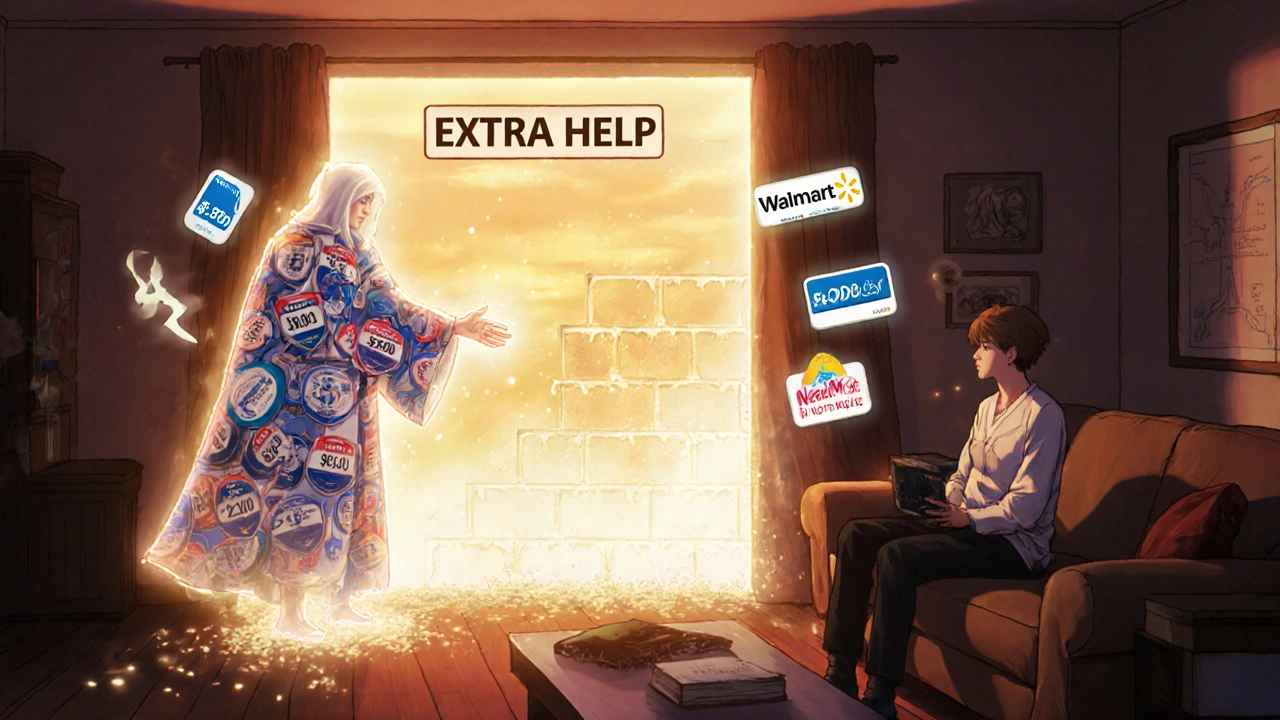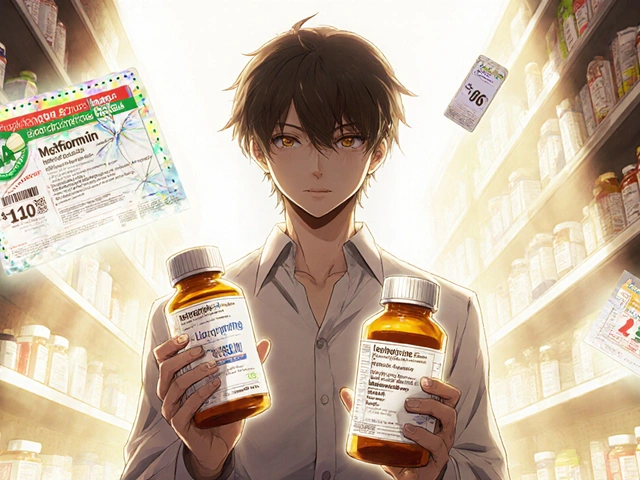Copay Assistance for Generics: How to Find Financial Help for Low-Cost Prescription Drugs

Generic drugs are supposed to save you money. But for millions of Americans, even the $5 or $10 copay for a generic medication can feel impossible. You’re not alone. Nearly one in four adults in the U.S. say they’ve skipped a dose or skipped filling a prescription because they couldn’t afford it - and many of those are for generic drugs. The system isn’t broken because generics are expensive. It’s broken because the help that’s supposed to make them affordable doesn’t reach the people who need it most.
Why Generics Still Cost Too Much
Generic drugs cost 80-85% less than brand-name versions. That’s not a guess. It’s a fact backed by the Association for Accessible Medicines. A 30-day supply of levothyroxine, for example, might cost $4 at Walmart. Metformin? $10. Lisinopril? $6. Sounds cheap, right? But if you’re on fixed income, working two jobs, or have high-deductible insurance, $32 a month for three generics adds up fast. And if your insurance plan has a $8,300 out-of-pocket cap before catastrophic coverage kicks in, every $10 copay counts toward that limit - even if you’re not using brand-name drugs.Here’s the catch: brand-name drugmakers often give you copay cards that reduce your cost to $0. Generic manufacturers? Almost never. Why? Because their profit margins are razor-thin. They can’t afford to subsidize patients the way Pfizer or Merck can. So the burden falls on you - and the few programs that exist are confusing, hard to qualify for, or exclude you entirely if you have Medicare or Medicaid.
Who Gets Help - and Who Doesn’t
The only reliable source of copay assistance for generics is government programs. Medicare’s Extra Help program (also called the Low-Income Subsidy) is the gold standard. In 2025, it caps your generic copay at exactly $4.90 per prescription. No more, no less. If you qualify, you pay $4.90 for your metformin, your lisinopril, your atorvastatin - every month, forever. And you don’t pay a deductible. That’s life-changing.But qualifying for Extra Help isn’t easy. You need to meet strict income limits: $21,870 for a single person, $29,580 for a couple in 2025. If you make $2,200 a month - $26,400 a year - you’re just $4,530 too high to qualify. That’s the “assistance cliff.” You’re not rich. You’re not on Medicaid. But you’re not eligible for help either. And no manufacturer card is going to save you. That’s where people get stuck.
Commercial insurance patients face their own problems. Even though your plan puts generics on Tier 1 with a $5 copay, you might still pay more if your insurer uses a copay accumulator program. That means any help you get - like a pharmacy discount - doesn’t count toward your deductible or out-of-pocket max. But here’s the twist: since generic manufacturers rarely offer copay cards, accumulators mostly hurt brand-name users. For generics, the bigger issue is just getting the discount in the first place.
The Real Lifelines: Pharmacy Discount Programs
You don’t need a doctor’s note, tax forms, or a 90-day wait to get help from pharmacy discount programs. These are the most underused tools in the system.- Walmart’s $4/$10 list: Covers over 150 generics, including levothyroxine, metformin, lisinopril, and hydrochlorothiazide. No insurance needed. Just ask for the list at the counter.
- Kroger’s $15 generics program: Similar to Walmart, but with a slightly different list. Good for people who shop there anyway.
- SingleCare, GoodRx, RxSaver: These apps give you printable or digital coupons. You can use them even if you have insurance - but only if the cash price is lower than your insurance copay. Always compare.
A 2024 American Pharmacists Association study found that 62% of patients don’t even ask for these discounts. They assume their insurance is the only way. It’s not. In many cases, the cash price with a coupon is cheaper than your copay. Always check. It takes 30 seconds. And it could save you $20, $50, even $100 a month.

Nonprofit and Patient Assistance Programs
If you’re struggling and don’t qualify for Extra Help, nonprofit organizations can help - but they’re picky. The PAN Foundation, for example, has 72 assistance programs. Only 17 of them cover conditions that are mostly treated with generics - like hypertension, diabetes, and hypothyroidism. You need to meet income limits (usually under 250% of the federal poverty level - $37,150 for one person in 2025), have a confirmed diagnosis, and be a U.S. resident. The application takes 3 weeks to process. Approval rate? 78% if you qualify. But if you’re making $38,000 a year? You’re out of luck.NeedyMeds is another key resource. It’s a free database that lists over 1,000 assistance programs, including ones from drugmakers, nonprofits, and state agencies. You can search by drug name, condition, or income level. It’s not glamorous, but it’s real. And it’s free.
Medicare Part D Changes in 2025 - What You Need to Know
The Inflation Reduction Act is changing everything for Medicare beneficiaries. Starting January 1, 2025:- Your annual out-of-pocket spending cap for all drugs - brand or generic - drops from $8,300 to $2,000.
- Extra Help recipients will pay $0 deductible and $2.00 monthly for insulin (including generic).
- During the coverage gap (donut hole), no one pays more than $100 per quarter for generics.
This is huge. For someone taking five generics a month at $4.90 each, that’s $24.50 a month - $294 a year. Before 2025, that $294 counted toward the $8,300 cap. Now? It doesn’t matter. Once you hit $2,000, you pay nothing for the rest of the year. That means even if you’re not on Extra Help, you’ll eventually get full coverage. But here’s the catch: you still have to pay up to $2,000 first. If you’re on a fixed income, that’s still a mountain to climb.
How to Get Help - Step by Step
If you’re paying too much for generics, here’s what to do - right now:- Check your cash price with GoodRx or SingleCare. Compare it to your insurance copay. Use the lower one.
- Ask your pharmacy if they offer a discount list. Walmart, Kroger, Costco, and Target all have them.
- Apply for Extra Help if you’re on Medicare. Go to medicare.gov or call 1-800-MEDICARE. You can apply even if you think you earn too much - the rules are complicated.
- Use NeedyMeds.org to search for assistance programs by drug name. Don’t skip this step.
- Contact your State Health Insurance Assistance Program (SHIP). They offer free, personalized counseling. Find yours at shiptacenter.org.
Successful applicants use an average of 2.3 assistance sources. Don’t rely on just one. Apply for everything you might qualify for. Even if you get denied, you’ve tried. And you’ve saved money on your next refill.

The Hidden Risk: Skipping Medications
The biggest danger isn’t the cost - it’s what you do when you can’t pay. A 2023 study in the Annals of Internal Medicine found that 38% of people who couldn’t afford their generics skipped doses or stopped taking them entirely. That’s not just risky - it’s deadly. Uncontrolled high blood pressure, unmanaged diabetes, untreated thyroid disease - these aren’t minor issues. They lead to hospitalizations, strokes, heart attacks. The cost of skipping your pill is far higher than the cost of the pill itself.Don’t let pride or confusion stop you. There are options. You just have to know where to look.
What’s Next? The System Is Changing - But Slowly
The generic drug market is huge - $82.7 billion in 2023. Ninety-two percent of prescriptions are for generics. Yet only 8.7 million people received formal assistance. That means 21.3 million people are paying full price - or worse, going without.The Inflation Reduction Act is the biggest shift in decades. By 2025, most Medicare beneficiaries will pay less for generics than ever before. But for people just above the income cutoff - the working poor, the early retirees, the part-timers - the gap remains wide. No one’s talking about them. But they’re the ones who need help the most.
Until we fix that gap, the promise of affordable generics will stay just out of reach for millions. For now, your best tools are awareness, persistence, and asking the right questions at the pharmacy counter.
Can I use a GoodRx coupon with my Medicare Part D plan?
Yes, but only if the cash price with the coupon is lower than your Medicare copay. Medicare doesn’t allow you to apply the coupon toward your deductible or out-of-pocket maximum. You can choose to pay cash instead of using your insurance - but you must ask the pharmacist to process it that way. Always compare prices before deciding.
Why don’t generic drug companies offer copay cards like brand-name makers?
Generic manufacturers operate on very thin profit margins - often less than 10% per pill. Brand-name companies charge high prices and use copay cards to keep patients on their drugs. Generic companies compete on price, not subsidies. Offering copay cards would require them to raise prices or cut into profits, which defeats the purpose of generics. That’s why help comes from pharmacies, nonprofits, and government programs instead.
What if I make too much for Extra Help but still can’t afford my meds?
You’re in the “assistance gap.” Apply for help anyway - income rules can be flexible. Use NeedyMeds to find nonprofit programs that cover your condition. Check pharmacy discount lists. Talk to your pharmacist about therapeutic alternatives - sometimes a different generic version is cheaper. And contact your State Health Insurance Assistance Program (SHIP). They’ve helped people in your exact situation thousands of times.
Do all pharmacies accept GoodRx or SingleCare coupons?
Most major chains - CVS, Walgreens, Walmart, Kroger - do. Independent pharmacies may not, but many will still honor them if you ask. If one pharmacy says no, try another. Coupon acceptance varies by location and contract agreements. Don’t give up after one try.
Will the $2,000 out-of-pocket cap in 2025 help people who take only generics?
Yes - and it’s one of the biggest wins for generic users. Because generics are cheaper, you’ll reach the $2,000 cap faster than someone taking expensive brand-name drugs. Once you hit it, you pay nothing for the rest of the year. For someone taking five generics at $4.90 each, that’s just $294 a year. That means you’ll hit the cap in under 7 months. After that, your meds are free for the rest of the year.
Can I apply for Extra Help if I have a Medicare Advantage plan?
Yes. Extra Help works with any Medicare Part D plan, including those offered through Medicare Advantage. You don’t need to switch plans. Just apply for Extra Help through Medicare.gov or by calling 1-800-MEDICARE. Once approved, your drug costs will automatically adjust - even if you’re in a Medicare Advantage plan.
What to Do Today
Don’t wait for the system to fix itself. Right now, open your medicine cabinet. Look at your prescription bottles. Write down the names of your generics. Go to GoodRx.com or download the SingleCare app. Check the cash price. Then call your pharmacy and ask: “Is there a discount list for these drugs?” If you’re on Medicare, call 1-800-MEDICARE and ask about Extra Help. It’s free. It’s confidential. And it could cut your monthly drug bill in half - or more.Generic drugs are meant to be affordable. But affordability doesn’t happen by accident. It happens when you know where to look - and when you’re willing to ask for help.


omg i just found out walmart sells metformin for $4?? i’ve been paying $15 with insurance lmao why no one told me??
I’ve been using GoodRx for my lisinopril for years. Cash price is $3.50. Insurance copay? $12. Always check. Pharmacies don’t tell you this. You have to ask. It’s not rocket science. Just do it.
Bro this post is just a 10-minute google search away. Why is this even a thing? People are still paying full price for generics? I’m not even mad. I’m just disappointed.
The system is designed to fail people who aren’t rich enough to afford insurance but too rich to qualify for help. That’s not a bug. That’s the feature. The real crime is how normal this feels now
I remember when my mom had to choose between her thyroid med and her insulin - she’d skip one, then the other, just to make both last. She was 68, worked two part-time jobs, and had Medicare Advantage. No one talked about this. No one cared. Now I’m 34, on the same meds, and I still have to check GoodRx every month. It’s not progress - it’s just the same pain with better branding.
In the UK, we have the NHS - generics are free at point of use, regardless of income. I know it sounds like a fantasy to some of you, but it’s real. The difference isn’t in the drugs. It’s in the moral architecture of the system. We don’t make people choose between food and medicine. We just… don’t.
The fundamental paradox of the American pharmaceutical system is that it incentivizes price transparency only when it benefits corporations. The very mechanism that should reduce cost - generic competition - is subverted by structural barriers to access. One cannot meaningfully speak of affordability when access is contingent upon bureaucratic literacy.
Check your pharmacy’s discount list. It’s free. It’s easy. It saves money. Do it.
The assistance cliff is a structural failure of means-testing in a neoliberal healthcare framework. When eligibility thresholds are rigidly calibrated to federal poverty levels without accounting for regional cost-of-living differentials or underemployment, you create a disenfranchised cohort of working poor who are functionally invisible to policy design. This is not an anomaly - it is the expected outcome of market-based rationing.